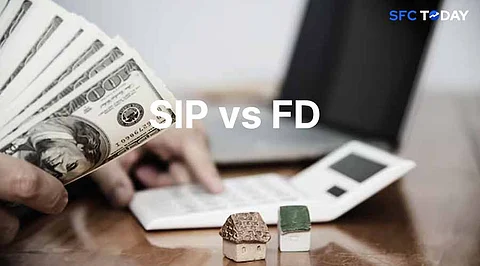

Investors in 2025 have a couple of choices to keep their money idle. Two of them are in vogue among them, and they are FD and SIP. Both have certain advantages, but they are for two different investment objectives and risk tolerance. In this article, the basic differences between FD and SIP will be realized for the investor's benefit.
Systematic Investment Plan (SIP) allows investing in a fixed amount of money at regular intervals in mutual funds. SIP brings discipline in investing with rupee-cost averaging and the advantage of compounding in the long run. Money is invested in equities, debt, or asset classes depending on the selected mutual fund. The advantage of compounding and rupee-cost averaging contribute to SIP being a successful approach towards wealth creation in the long run.
Fixed Deposits (FD) is a conventional investment plan where funds are invested for a specified duration of time in a bank or financial institution. The bank pays interest in the form of a specific rate. FDs are favored because it is guaranteed and there is no risk involved, and hence risk-free investor's most preferred alternative seeking surety of returns for a fixed duration of time.
Although SIP as well as FD are investments, they are different in terms of return, risk, and flexibility. All these are of paramount importance while choosing the best for various money objectives.
Returns: On relative basis of returns, SIP gives higher returns compared to FD in the long term. The SIP returns are market-linked, i.e., based on the performance of underlying mutual funds. In the past, equity-linked SIPs have yielded better returns, particularly if the SIP is for 5-10 years. FD gives returns in the shape of fixed interest depending upon prevailing interest rates. If the FD interest rates are usually 5-7%, then the return is sure but not as satisfactory as the return on investment through SIP.
Risk: SIP is not free from risk entirely because the investment is in the market. Equity markets are as fluctuating, and SIP returns too will fluctuate along with the market. But taking an extended time for holding, the greater the chances that the SIP investors will ultimately beat short-term fluctuations. FD is highly safe. Investment in FD is not subject to any risk, and the investor will be given a certain return on maturity. Thus, FD suits the risk-averse who seek capital security at the cost of higher returns.
Liquidity and Flexibility: SIP and FD vary on one point, and that is flexibility. SIP is relatively more flexible in the sense that investors can stop or modify their investment at any time without paying enormous penalties. Even SIP investments are allowed to be withdrawn partly or completely depending on the investor's requirements, although part of these funds also involves an exit load if withdrawn in a shorter timeframe.
FDs are not liquid, however. Low interest and penalty on withdrawal before the time. Yes, okay, there could be some banks where FD facility of premature withdrawal is available, but a term like this would be less attractive than having investment until tenure period. SIP is therefore chosen by the investors if there are liquidity needs or emergency fund needs.
The choice between FD and SIP in the year 2025 solely relies on the investment horizon, risk appetite, and financial goals of the investor. In regards to long-term wealth creation, SIP is always a good choice because it can offer higher returns based on the inflation. SIP is a benefit of compounding and growth, and it can suit investors who desire to receive more corpus after a very long time. The more risk-tolerant bearers with longer holding periods might consider SIP an efficient earning one.
FD, however, is suitable for who desire guaranteed returns and capital protection. Retirees or conservative investors who need guaranteed income can employ FD as it assures constant returns with the guarantee of not losing their capital. FD will also be suitable for those who have short-term objectives and need security and guaranteed returns in 2025.
Both SIP and FD are investment-type schemes but for investors with a different temperament. SIP would be most appropriate for these investors who aim at long-term wealth creation, are flexible with their time, and are willing to undergo some level of risk in the market. FD would be most appropriate for investors who are looking for security, stability, and guaranteed returns. In the year 2025, either SIP or FD will be chosen based on the investment objective and risk-taking capability of the investor. Individual goal and time frame will clarify what would be the most appropriate vehicle in which money needs to be invested so that it will be achieved most optimally.